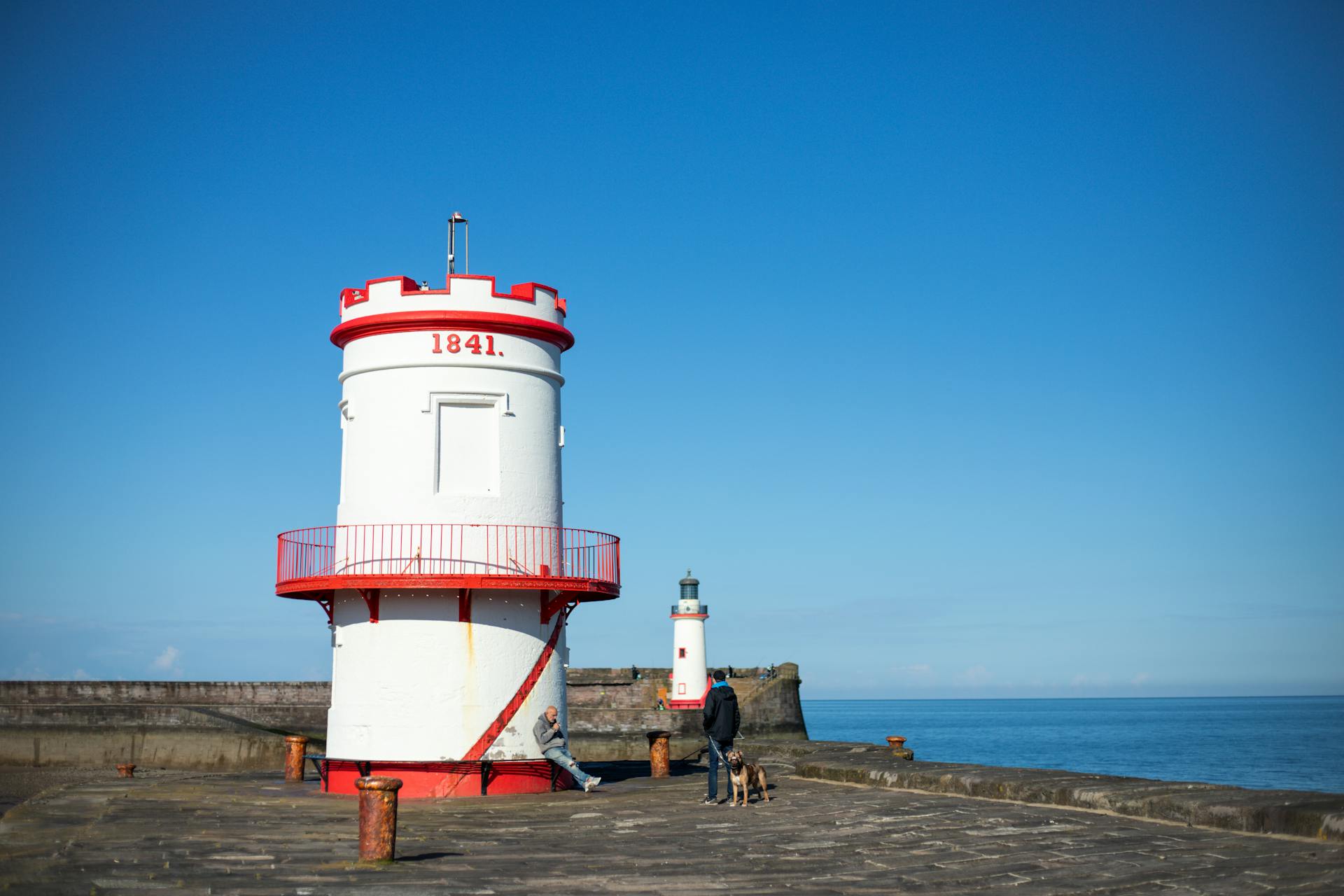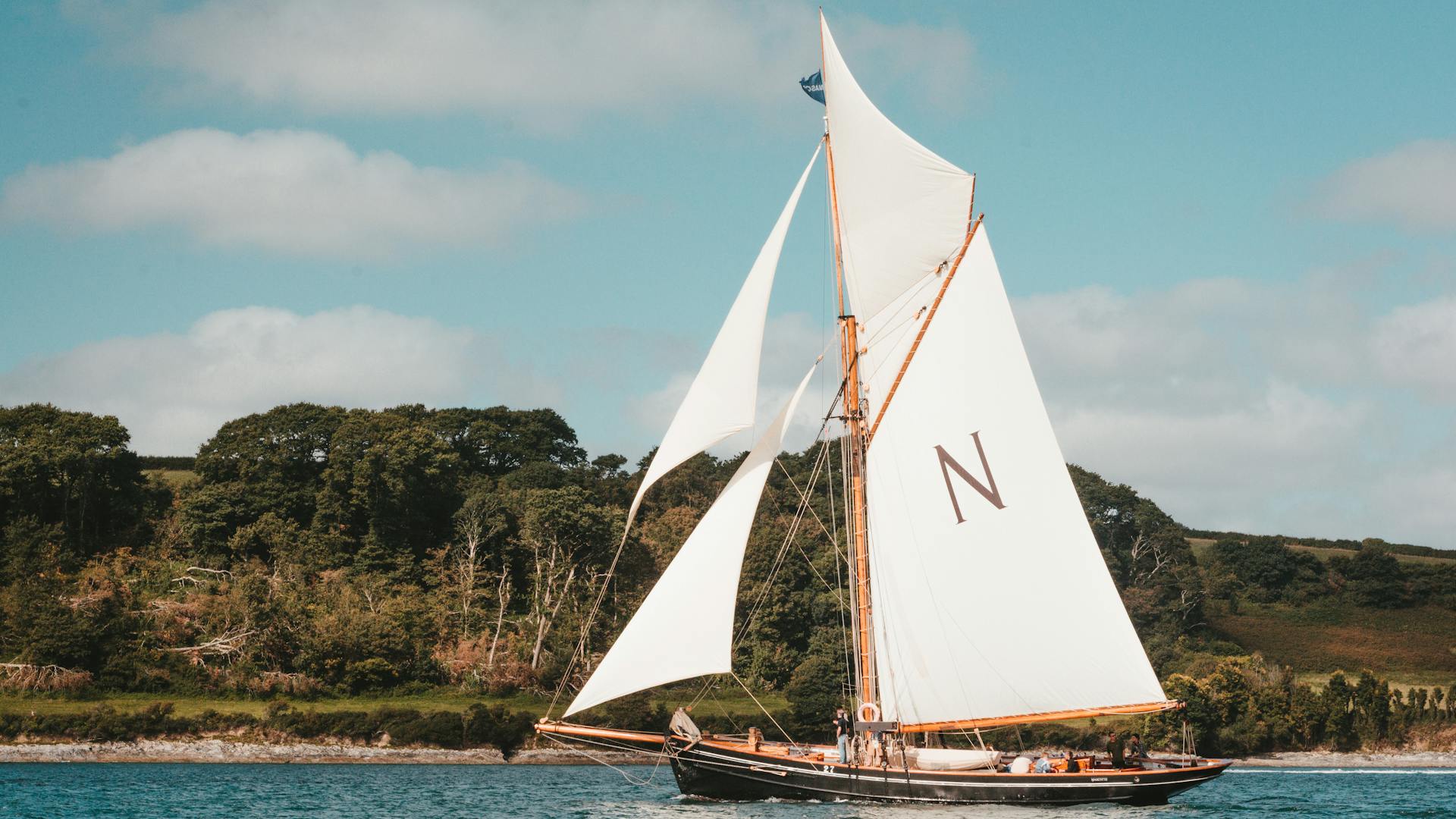
Falmouth is a charming coastal town in Massachusetts, New England, that's perfect for a relaxing getaway. It's located on the southern coast of Cape Cod, approximately 70 miles southeast of Boston.
The town has a rich maritime history, with its harbor serving as a major fishing port for centuries. Falmouth's picturesque harbor is still bustling with fishing boats and yachts today.
Falmouth is also a great destination for outdoor enthusiasts, with plenty of opportunities for swimming, kayaking, and hiking. Visitors can explore the town's many beaches, including Old Silver Beach and Surf Drive Beach.
Falmouth's scenic bike trails and scenic bike paths make it an ideal spot for cycling, with many routes offering stunning views of the ocean and surrounding countryside.
You might like: New York Harbor Storm-Surge Barrier
Day in Falmouth
Falmouth is a fantastic place to spend a day, with plenty of activities to keep you entertained. You can rent bikes at Corner Cycle or your Falmouth hotel and ride along the scenic Cape Cod Shining Sea Bikeway, which follows a former railroad route along the shoreline.
Explore further: National Maritime Museum Cornwall Falmouth
The bikeway is a great way to see the sights, and you can stop at one of the many beaches along the way to take a dip in the warm water. Point your tires towards Woods Hole, a classic Cape Cod town at the edge of the peninsula.
Lunch options abound in Woods Hole, with great spots like Pie in the Sky Bakery and Quicks Hole Taqueria serving up delicious food. History buffs will love the Woods Hole Historical Museum, and nautical enthusiasts will be fascinated by the Woods Hole Science Aquarium.
A visit to Nobska Lighthouse is a must for any Cape Cod vacation, offering stunning views of Martha's Vineyard and Nonamessett. If you're looking for a great place to eat, Quicks Hole Tavern is a top choice for fine seaside dining.
Accommodation and Transportation
When traveling to Falmouth, Massachusetts, it's essential to consider your accommodation options. You can choose from large resorts, cute B&Bs, or secluded hideaways like the Palmer House Inn, which features classic Cape Cod siding on a serene residential street.
For a family-friendly option, consider the ShoreWay Acres Inn, which is centrally located in Falmouth's historic district and offers indoor and outdoor pools, grills, and lawn games. Alternatively, the Captain's Manor Inn offers stately elegance with an 1849 black marble fireplace and flawlessly landscaped grounds.
Falmouth is also well-connected by transportation options. You can take Massachusetts Route 28, which runs south from Bourne and becomes a surface road through downtown, or use the Woods Hole, Martha's Vineyard and Nantucket Steamship Authority to travel to Martha's Vineyard and Nantucket.
Accommodation Choices
If you're looking for a family-friendly option, consider ShoreWay Acres Inn, which has indoor and outdoor pools, grills, and lawn games available.
ShoreWay Acres Inn is centrally located in Falmouth's historic district, making it easy to get around.
For a more secluded hideaway, try the Palmer House Inn, which features classic Cape Cod siding on a serene residential street in town.
The Palmer House Inn is a great choice for those seeking a peaceful retreat.
Captain's Manor Inn is another central option, with stately elegance including an 1849 black marble fireplace and flawlessly landscaped grounds.
Its elegant atmosphere and beautiful grounds make Captain's Manor Inn a great choice for couples celebrating a special occasion.
Transportation
Falmouth has a main road, Massachusetts Route 28, which runs south from Bourne as a divided highway and then becomes a surface road through downtown.
Route 28 is regularly congested due to its popularity as one of the two major east–west routes on the Cape, and there's minimal room for widening opportunities.
The Woods Hole, Martha's Vineyard and Nantucket Steamship Authority offers daily ferry service from Woods Hole to Nantucket and Martha's Vineyard, bringing tourists, residents, and supplies.
The ferry is the main line between the Vineyard and the mainland, with the seasonal Island Queen ferry running from Falmouth Harbor to Martha's Vineyard.
Intriguing read: Portsmouth England Ferry to Normandy
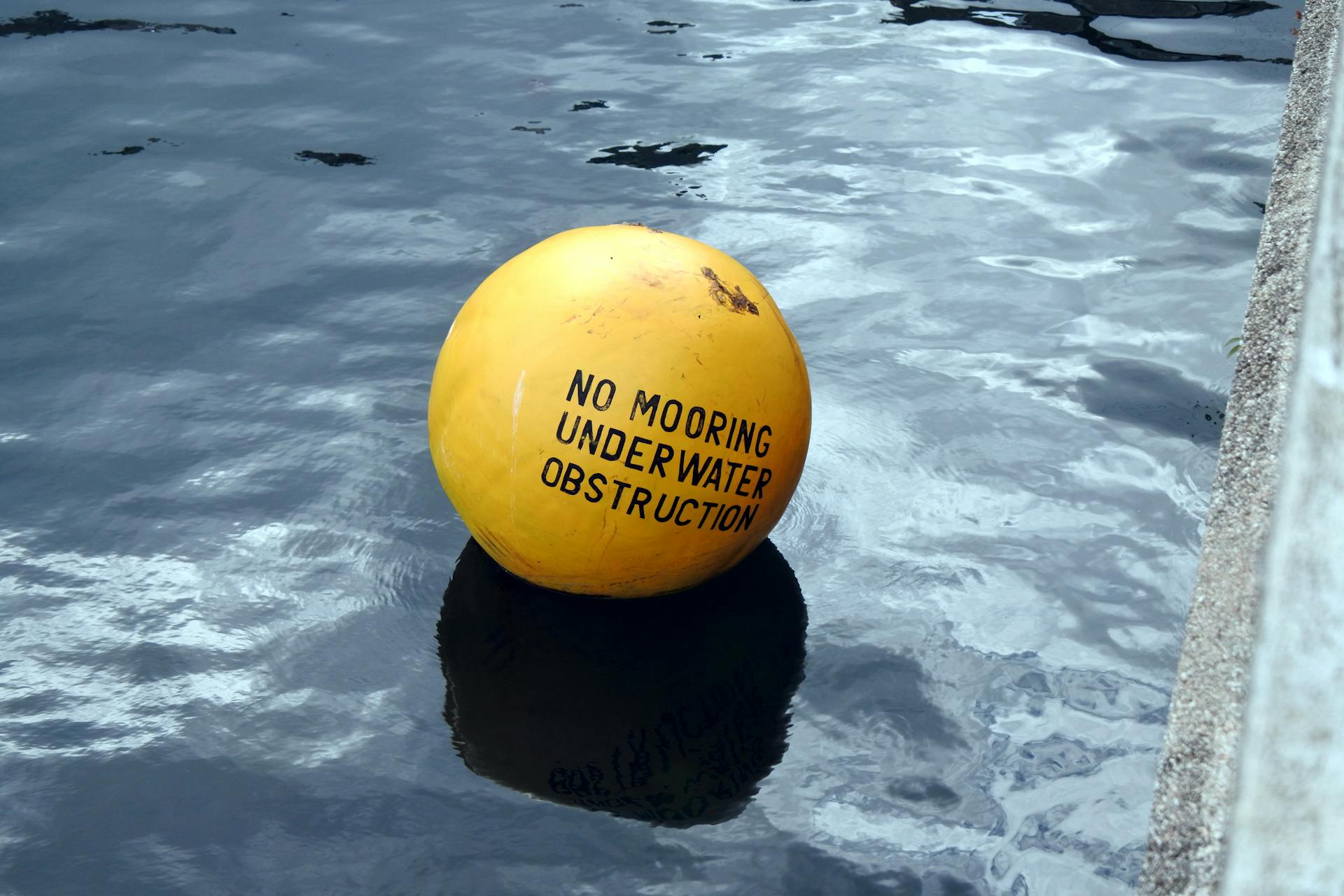
There's a private air park in East Falmouth, making it a convenient option for those who prefer flying.
The nearest national and international air service is at Logan International Airport in Boston and T. F. Green Airport near Providence, both being about equidistant from Falmouth.
The Cape Cod Regional Transit Authority bus routes serve Falmouth, providing an affordable and reliable public transportation option.
Here's a list of transportation options in Falmouth:
- Massachusetts Route 28
- Woods Hole, Martha's Vineyard and Nantucket Steamship Authority ferry
- Island Queen ferry
- Private air park in East Falmouth
- Cape Cod Regional Transit Authority bus routes
The nearest inter-city passenger rail stations are Providence and Boston's South Station, with the nearest MBTA Commuter Rail stations being Middleborough and Kingston.
The Massachusetts Coastal Railroad provides rail freight service to North Falmouth, where a spur runs into Otis Air Base to serve a trash transfer station.
Bike
The bike course is a must-drive beforehand, especially with the 15 mph speed limit on the Woods Hole Oceanographic Institute campus. Seriously consider driving it to get a feel for the route.
You'll be riding on a 8.5-mile course with several tight turns, both right and left, so be sure to exercise caution. Stay in the right lane at all times, as there is two-way bike traffic along much of the course.

You must securely fasten your helmet chin strap before removing your bike from the rack and keep it fastened until you return the bike to the rack. This is a strict rule, so be sure to follow it.
Here are some key bike course rules to keep in mind:
- Stay to the right except when passing.
- We enforce the USA Triathlon “no drafting” rule.
- LITTERING is grounds for penalty sanctioning!
The bike course turn-by-turn directions are as follows: exit transition on the far side, mount your bike, and ride on the right side of the road all the way to the main campus of the Woods Hole Oceanographic Institute. From there, follow the outer perimeter road of the campus to a sharp right-turn exit onto Oyster Pond Road.
Cape Cod and Surroundings
Falmouth is situated on the elbow of Cape Cod, where the coastline meets the mainland.
The town is surrounded by water, with the Atlantic Ocean to the east and Buzzards Bay to the west.
Falmouth's proximity to the ocean makes it a popular destination for beachgoers and water sports enthusiasts.
The Cape Cod Canal, which connects the Atlantic Ocean to Buzzards Bay, runs through the town and offers stunning views of the surrounding landscape.
Expand your knowledge: New York Bay
Cape Cod
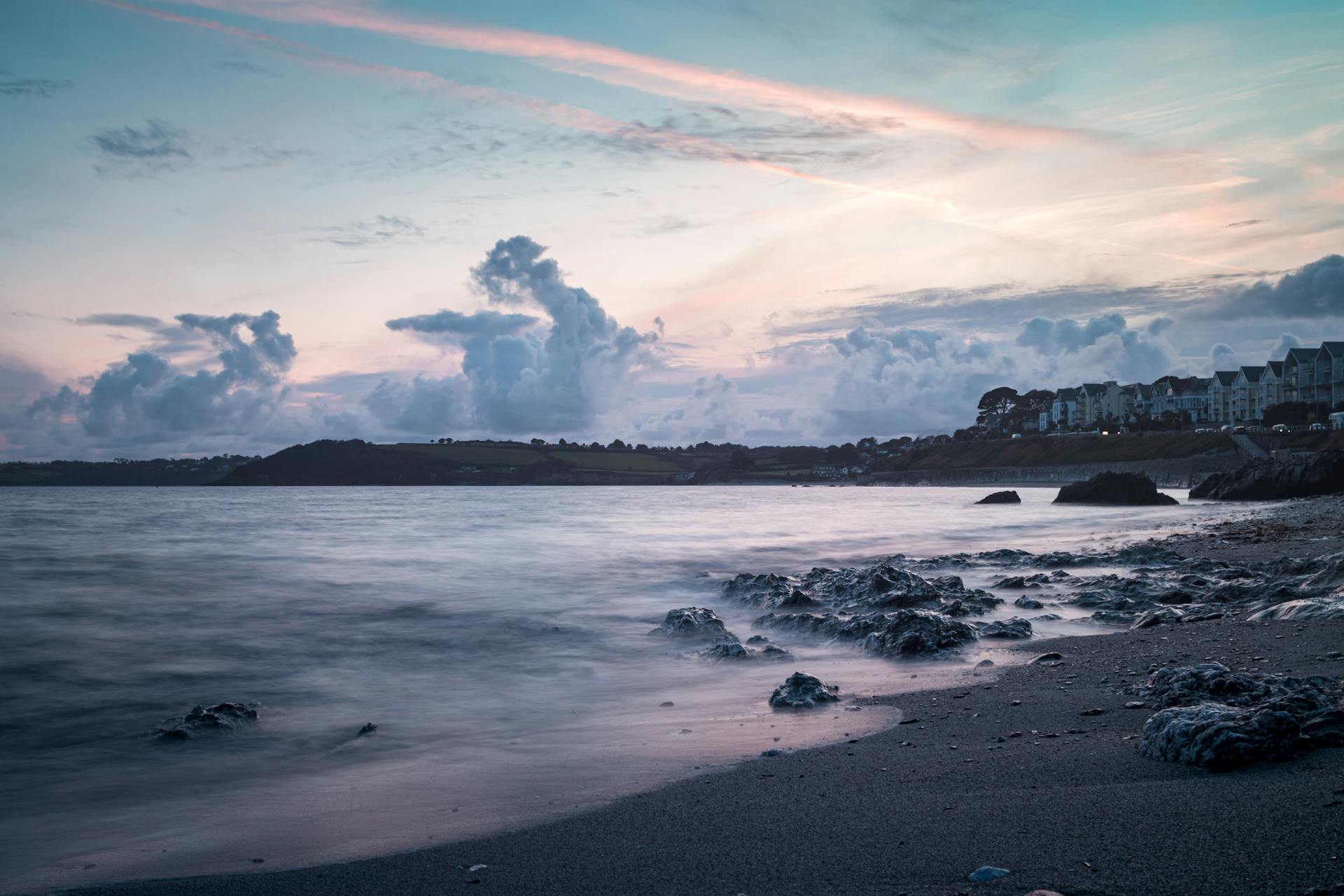
Cape Cod is a treasure trove of scenic bike rides, with the Cape Cod Shining Sea Bikeway being a standout attraction. This 21-mile paved path follows the shoreline from Falmouth to Woods Hole and beyond.
Rent bikes at your hotel or at Corner Cycle and explore the bikeway, which offers plenty of opportunities to take a dip in the warm water along the way. The bikeway is perfect for a leisurely ride or a more energetic bike tour.
Woods Hole is a classic Cape Cod town at the edge of the peninsula, with a charming downtown area and a scenic boardwalk. Be sure to visit the Woods Hole Science Aquarium, which is a must-see for nautical enthusiasts.
History buffs will enjoy a visit to the Woods Hole Historical Museum, which offers a glimpse into the town's rich history. For a classic Cape Cod vacation photo op, head to Nobska Lighthouse and take in the stunning views of Martha's Vineyard and Nonamessett.
After a day of exploring, head to Quicks Hole Tavern for fine seaside dining, or grab a bite to eat at Pie in the Sky Bakery or Quicks Hole Taqueria.
Additional reading: Maritime History of England
Geography
Cape Cod is a beautiful place, and its geography is one of its most striking features. The town of Falmouth, located on the southwestern tip of the cape, has a total area of 54.4 square miles, with 19.04% being water.
Most of Falmouth sits on glacial sands composed of glacial outwash deposits, but the southwestern part of the town has a more rocky and dense soil, similar to the rest of New England. This is due to moraine deposits that were left behind by retreating glaciers.
Falmouth's climate is temperate marine, with evenly distributed rainfall throughout the year, averaging 2 to 3 inches per month. This makes it a great place to visit any time of the year.
The town is bordered by Bourne and Sandwich to the north, Mashpee to the east, Vineyard Sound to the south, and Buzzards Bay to the west. At its closest point, Falmouth is just 560 yards from Nonamesset Island.
Falmouth's topography is characterized by many small ponds, creeks, and inlets, often surrounded by pine and oak trees. The southern shore is particularly notable for its series of ponds and rivers, including Falmouth Inner Harbor, Little Pond, and Great Pond.
The Buzzards Bay side of the town is primarily made up of bays divided by necks and peninsulas connected to land by isthmi. The largest inlet is Megansett Cove, located along the Bourne town line.
History and Culture
Falmouth was first settled by English colonists in 1660 and was officially incorporated in 1686. The settlement was named after Falmouth, Cornwall, England, the home port of Bartholomew Gosnold.
Falmouth saw brief action in the War of 1812, when the area around Falmouth Heights was bombarded by British frigates and ships of the line. The Massachusetts militia hastily entrenched themselves on the beaches to repulse a possible British landing.
The town's economy grew with the introduction of Merino sheep and water-powered mills that could process the wool, making sheep husbandry a popular activity by the early 19th century. Falmouth averaged about 50 sheep per square mile in 1837.
History

Falmouth was first settled by English colonists in 1660 and was officially incorporated in 1686. The settlement was named after Falmouth, Cornwall, England, the home port of Bartholomew Gosnold.
Early activities in Falmouth included farming, salt works, shipping, whaling, and sheep husbandry, which was popular due to the introduction of Merino sheep and the beginnings of water-powered mills that could process the wool.
By 1837, Falmouth averaged about 50 sheep per square mile, a testament to the area's rich agricultural history. In the late 19th century, cranberries were being cultivated and strawberries were being raised for the Boston market.
The area saw brief action in the War of 1812, when the British bombarded the coast, but the Massachusetts militia successfully repelled the potential landing. This event had a lasting impact on the area's history.
By 1872, the train had arrived in Falmouth and Woods Hole, and summer homes began to sprout up. The arrival of the train marked a significant turning point in Falmouth's development.
The late 1800s saw the establishment of Highfield Hall, a museum built by James Madison Beebe on over 700 acres of land. Much of the land is still preserved as Beebe Woods today.
A fresh viewpoint: Postage Stamps and Postal History of New Zealand
Historic Districts
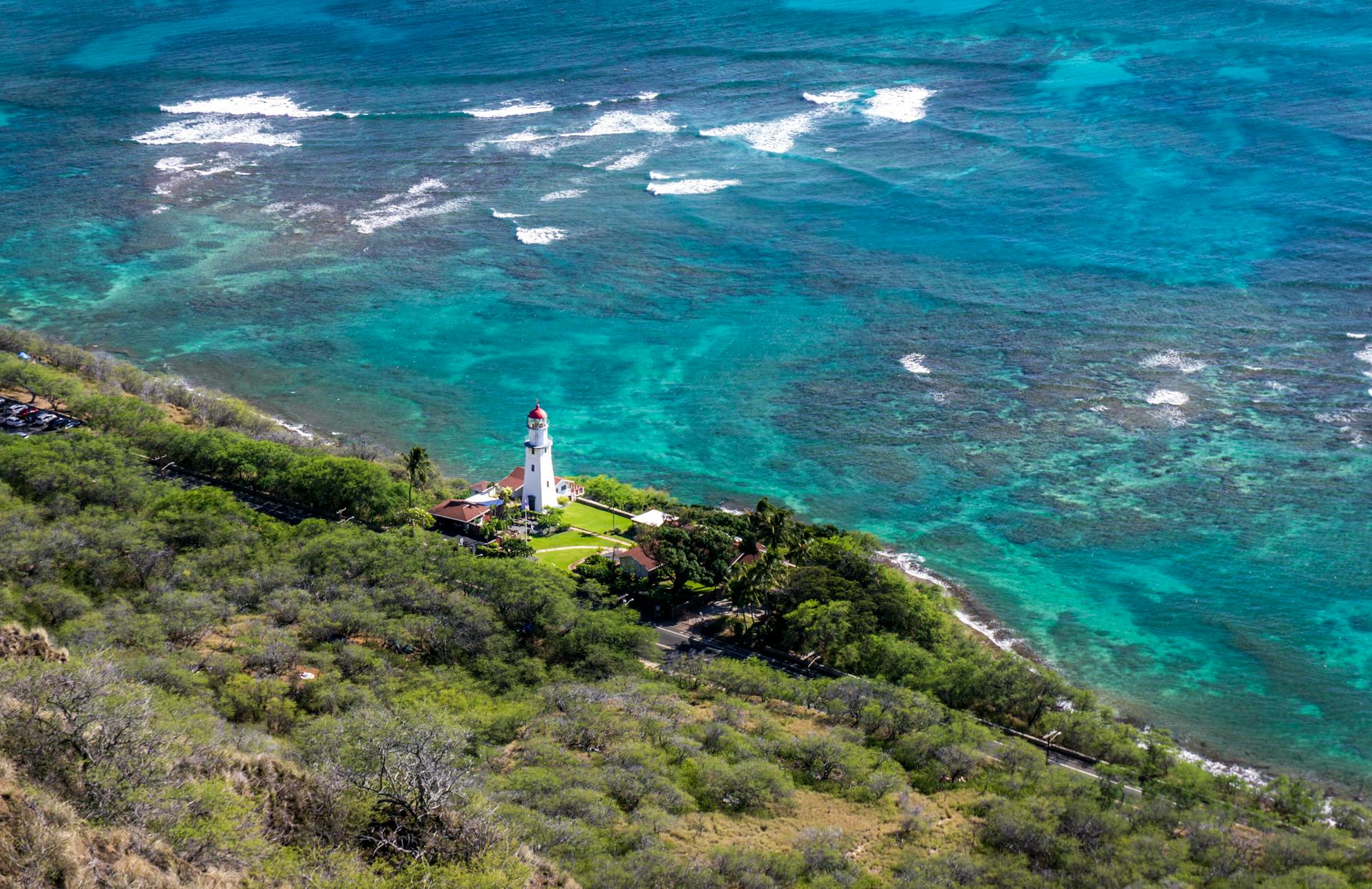
Falmouth has a rich history, and one way to experience it is by exploring its historic districts. The town boasts seven historic districts, including four that are listed on the National Register of Historic Places.
Falmouth Village Green, North Falmouth Village, Waquoit, and West Falmouth Village are just a few of the notable historic districts in Falmouth. These districts showcase the town's well-preserved architecture and provide a glimpse into its past.
The other three historic districts are located in Woods Hole, Davisville, and Quissett. These areas are also steeped in history and are worth exploring.
Here are the seven historic districts in Falmouth:
- Falmouth Village Green
- North Falmouth Village
- Waquoit
- West Falmouth Village
- Woods Hole
- Davisville
- Quissett
Arts and Entertainment
Falmouth is home to a vibrant theatre community, with the College Light Opera Company performing at the Highfield Theatre every summer since 1969.
The Cape Cod Conservatory and the Falmouth Arts Guild are also part of the town's thriving arts scene.
Falmouth holds a yearly Christmas parade in December that runs along Main Street in downtown Falmouth, a festive event that's a must-see.
The Woods Hole Film Festival, established in 1991, showcases local and international films in a week-long event at the end of July, making it the oldest independent film festival on Cape Cod.
Environment and Ecology

Falmouth, Massachusetts is home to a unique blend of vegetation types. The Northeastern Oak/Pine (110) vegetation type is the primary type found in the area.
This type of vegetation is characterized by a mix of oak and pine trees, which are well adapted to the region's climate. The Southern Mixed Forest (26) vegetation form is also present, adding to the area's biodiversity.
The combination of these vegetation types creates a thriving ecosystem that supports a wide range of plant and animal life.
Climate
Falmouth, Massachusetts has a unique climate that's worth exploring. The Köppen climate classification system categorizes it as a warm-summer, wet year-round, humid continental climate (Dfb).
This climate type is characterized by at least one month with an average mean temperature ≤ 32.0 °F (≤ 0.0 °C) and at least four months with an average mean temperature ≥ 50.0 °F (≥ 10.0 °C). Falmouth meets these criteria, with January being the coldest month and July being the warmest.
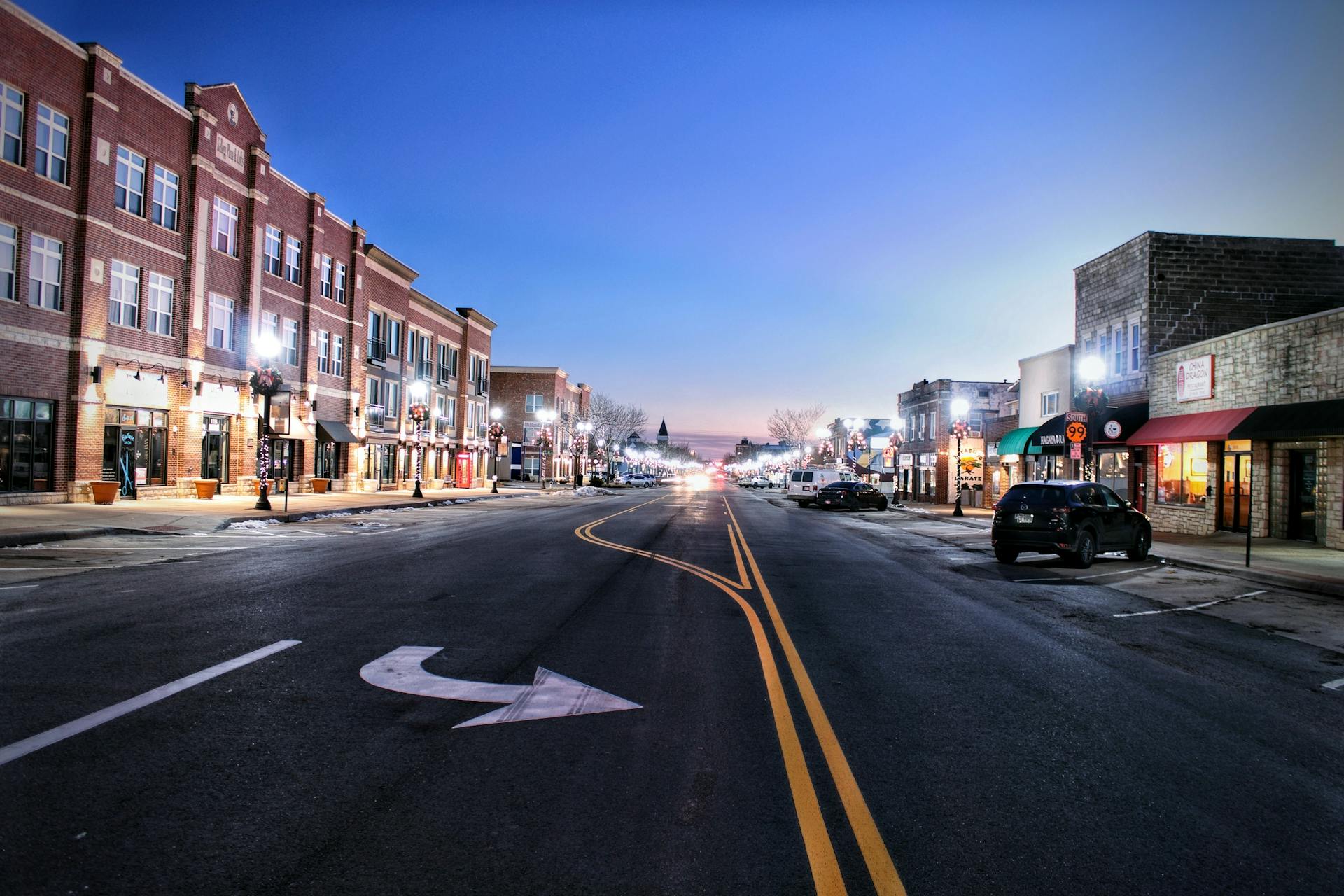
The average seasonal snowfall total is approximately 30 inches (76 cm), with February being the snowiest month. This is no surprise, given the annual peak in nor'easter activity that occurs during this time.
Here's a breakdown of the average temperatures throughout the year:
The average relative humidity is around 71%, with the highest levels occurring in July and August, reaching up to 75.6%. This can make the summer months feel quite humid.
Overall, Falmouth's climate is characterized by cold winters and mild summers, with significant precipitation throughout the year.
Ecology
Falmouth, Massachusetts is primarily made up of a Northeastern Oak/Pine (110) vegetation type. This type of vegetation is common in the region.
The Southern Mixed Forest (26) vegetation form is also present in Falmouth, Massachusetts. This form is characterized by a mix of tree species.
The A. W. Kuchler U.S. Potential natural vegetation Types provides insight into the natural vegetation of Falmouth, Massachusetts. This classification system helps us understand the region's ecosystem.
Groundwater Pollution
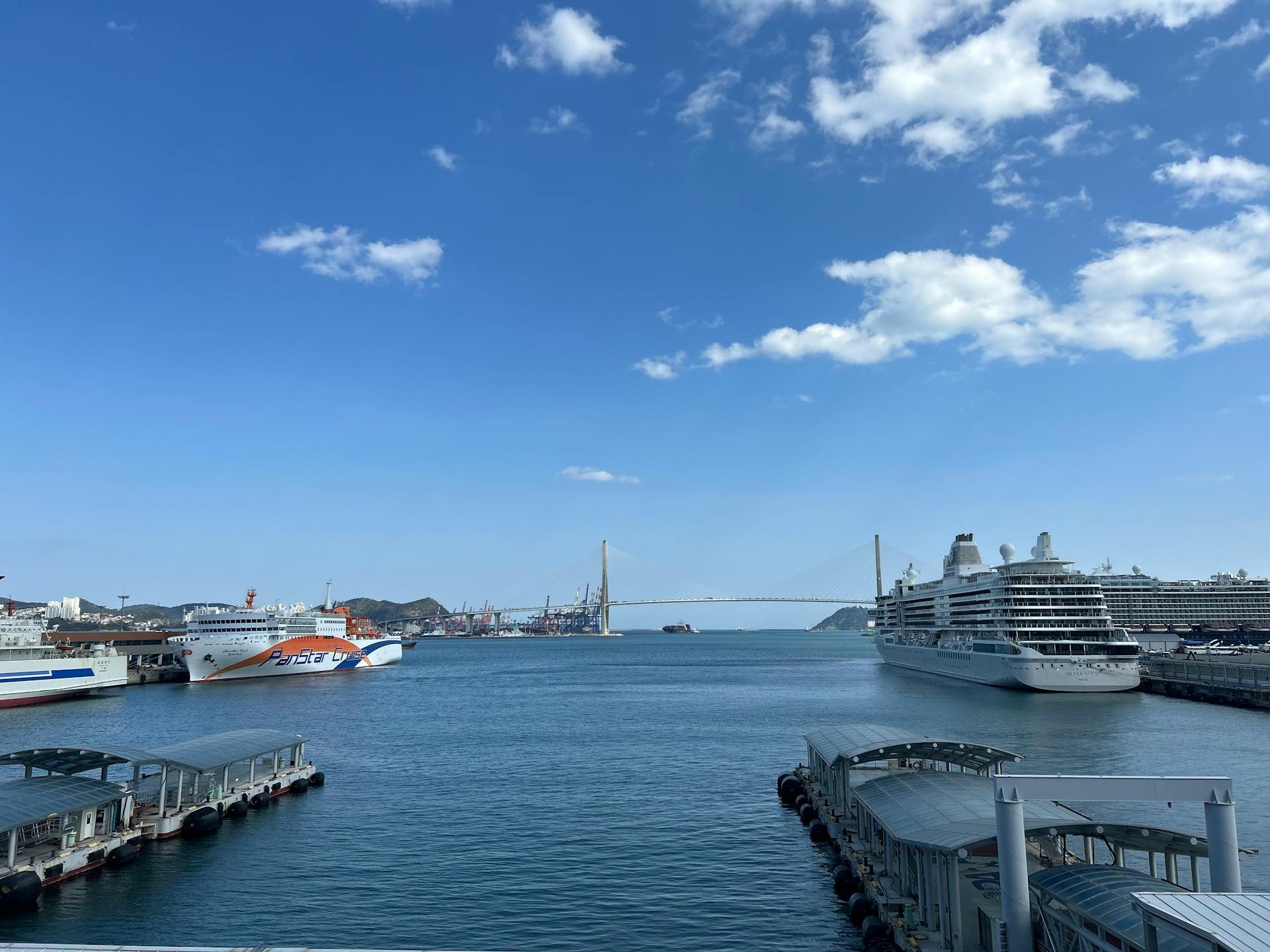
Groundwater pollution is a serious issue in Falmouth, Massachusetts, where toxic chemicals from the Massachusetts Military Reservation have contaminated household well water in some neighborhoods. The contamination was discovered in the 1970s and 1980s.
A major report was released on the contamination in 1986, and the Air Force Center for Environmental Excellence (now known as the Air Force Center for Engineering and the Environment) assumed responsibility for the cleanup in 1996. They treated soils at several sites and installed pumping wells to contain the plumes of groundwater contamination.
In 2010, the Silent Spring Institute tested about 20 public water supplies and found that 40% had detectable levels of perfluorinated compounds (PFCs). Elevated levels of 1,4-dioxane were also detected in some areas.
Since 2016, four houses in the Currier Road neighborhood have been receiving bottled water due to elevated levels of PFCs, such as PFOS and PFOAs, which were established as national standards by the U.S. Environmental Protection Agency.
Additional reading: New York Water Taxi
Frequently Asked Questions
Is Falmouth, MA a nice place to live?
Falmouth, MA is a beautiful and safe place to live, but it comes with some trade-offs like crowds in the summer and higher costs. If you're willing to overlook these drawbacks, it's a great choice.
Sources
- https://www.newenglandinnsandresorts.com/inspiration/the-blog/weekend-away-a-quick-cape-cod-vacation-in-falmouth-ma
- https://neeevents.com/race-details-falmouth/
- https://www.capecodchamber.org/explore/regions/upper-cape/falmouth/
- https://en.wikipedia.org/wiki/Falmouth,_Massachusetts
- https://www.audleytravel.com/us/usa/new-england/places-to-go/falmouth
Featured Images: pexels.com


